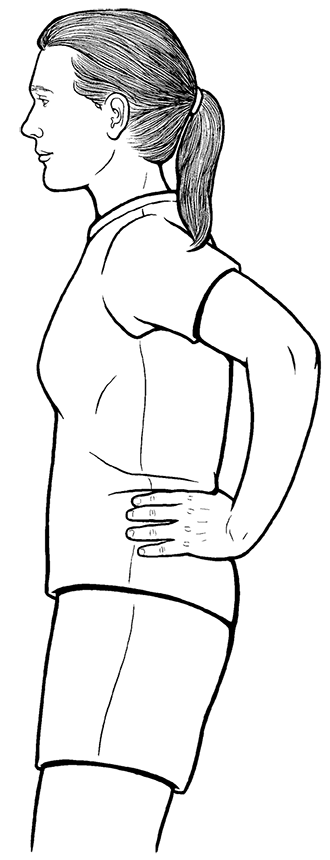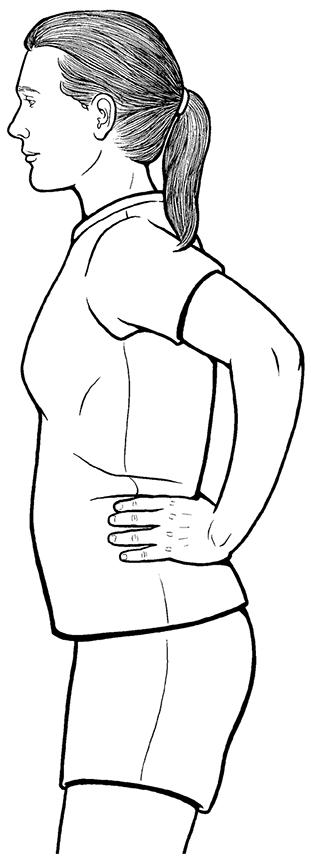Chinese Healing Exercises (18 page)
Read Chinese Healing Exercises Online
Authors: Steven Cardoza
Tags: #Taiji, #Qi Gong, #Daoist yoga, #Chinese Healing, #Health, #medicine, #remedy, #energy

Figures 6.2A and 6.2B (Torso Twist with Arm Swing)
Hold your arms in front of you as though hugging a tree. Hold them at the height of the tight area of your back that you want to target most
(
Fig 6.2A
).
As above, stay perpendicular to the ground, and turn from side to side, pivoting around your centerline. The difference here is that you want to lead the turn with your elbows, as though you were jabbing someone behind you, so as you turn to the left, lead with your left elbow, and then with your right as you turn to the right
(
Fig 6.2B
).
Try to maintain the sense of hugging the tree, so that your hands and arms don't collapse in toward your body much. The weight of your arms alone is enough to add to the torque in your spine at the targeted vertebral segments, so don't use much force with the backward jab of your elbow. Feel free to experiment with your arms' height level until you find what feels best to you. Even though you can't lower your arms below the height of your elbows in this exercise, at that lowest point it will also increase the twist in your low back, allowing you somewhat more access to that region too. You may feel or hear cracks and pops in your back, just as in a chiropractic adjustment. That's normal and should not be cause for alarm.
Variation Two: Hug a Tree with Qigong Energetics, for Daimai:
The Daimai, or girdling or belt meridian, is the only one which has a horizontal trajectory around the torso. It intersects all the Twelve Regular meridians, and the remaining seven of the Eight Extraordinary meridians, being the eighth itself. One of its functions is to bind and stabilize all the other meridians, and in that capacity it has a positive effect on the entire body. It also intersects the Dantian in the front of the body, and the kidneys and the Mingmen at the rear of the body. All the extraordinary meridians serve as reservoirs of Qi and Blood. Due in part to its location and intersections, the Daimai influences all reproductive health, and plays a particularly beneficial role in gynecological health.
Practice this variation only after you have some success practicing Dragon
Playing with a Pearl
, in chapter 11. It will only have noticeable beneficial effect if you can make a tangible qi connection between your hands and your torso, and Dragon Playing with a Pearl will help you to cultivate that ability.
Here you will begin as in the first variation above, and will place your arms in front of you as though hugging a tree, with this difference: start with your hands as far away from your body as possible, with your palms facing you at the height of your Dantian, just a little below your belly button. Gradually move them closer to your belly, until you feel a distinct energetic connection from your palms to your torso. That energetic connection should feel very much the same as the one you made between your palms when practicing Dragon Playing with a Pearl. This one is more challenging than feeling the qi between your palms only, so be patient and be honest with yourself as to what you are feeling.
Keep your torso perpendicular to the ground, and turn from side to side, slowly pivoting around your centerline. Try to maintain the sense of hugging the tree, so that your hands and arms don't collapse in toward your body, and keep the distance between your fingers as uniform as possible as you turn. You won't be leading with your elbows here. More importantly, maintain the sense of energetic connection from your hands to your torso. Your palms should trace the trajectory of your Daimai at the front portion of your body only, from just above one hip to the other hip, or as near as you can get.
As you turn to the right, slightly cup the palm of your right hand, pulling your
qi through the Daimai to the right, as you slightly straighten your left palm, pushing your
qi to the right. Reverse that as you turn to the left. Do this in each direction as many times as you'd like. This will smooth and harmonize qi flow through your Daimai, and will engender a feeling of peacefulness and be calmly energizing. If you're working to remedy a reproductive or gynecological problem, fifteen or twenty minutes a day is recommended.
2. Pelvic Tilt (Forward and Back)
Purpose
Physical:
Releases tension in the low back muscles; mobilizes the lumbar vertebrae, increases blood flow to and around the kidneys.
Energetic:
Frees qi obstruction in the lower Du meridian and the Mingmen (reducing low back pain from qi and blood stagnation); promotes qi flow through the Du, Ren, and Dai meridians; benefits the Kidneys.
Techniques used
Stretching, joint mobilization, focused breathing.
Method
Stand with your feet parallel, shoulder width apart. Feet parallel is especially important in this exercise, as low back tension frequently causes feet to splay outward at the toes. If you keep your feet parallel, you will increase the stretch exactly on those tight areas of your low back.
 Figure 6.3 (Pelvic TiltâForward and Back)
Figure 6.3 (Pelvic TiltâForward and Back)
Optionally, and a good idea for the first few times you try this at least, place your hands on the sides of your hips, so that your little fingers are at or slightly above the crest of your hipbones, fingertips forward. Spread your thumbs to your back, so that the pads and tips of the thumbs are just below your lowest ribs, as close to your spine as they can naturally reach. Your thumbs are now in a position to be a landmark to assist you in doing this exercise optimally
(
Fig 6.3
).
Slowly inhale deep into your belly, and as you do so, tilt your pelvis so that your tailbone moves forward, stretching and opening the back of your low spine
(
Fig 6.4A
).
If you can get the pressure from your breath to reach your lower belly, that will increase the stretch in your low back. Try to keep the stretch confined to the region below your thumbs, from their tips down to your tailbone. While it's not bad or dangerous to allow the portion of your back higher than your thumbs to move, it can easily minimize the amount of stretch in your lower back, which is the particular focus of this exercise. On an exhalation, tilt your pelvis in the opposite direction, moving your tailbone and your butt rearward, again doing your best to confine the motion to the region below your thumbs
(
Fig 6.4B
).
This will increase the natural concave curve of your lumbar spine. Repeat this at least ten times, but after that you can continue for as long as you'd like.


Figure 6.4A and 6.4B (Pelvic Tilt âForward and Back)
If your low back is particularly tight, as is true for many people, you may feel or even hear crackling in your low back during this exercise, and as your back opens more over time, you may even feel or hear a vertebra snap or pop, like getting a spinal adjustment. In the absence of pain, this is normal, beneficial, and nothing to be alarmed by.
3. Hula Rolls
Purpose
Physical:
As a continuation of what came before, while introducing new planes of motion, it will release tension in the low back muscles, mobilize the lumbar vertebrae, and increase blood flow to and around the kidneys.
Energetic:
Frees qi obstruction in the lower Du meridian and the Mingmen (reducing low back pain from qi and blood stagnation); promotes qi flow through the Du, Ren, and Dai meridians; benefits the kidneys.
Techniques used
Stretching, joint mobilization, focused breathing.
Method
Stand with your feet parallel, shoulder width apart or slightly wider. If you keep your feet parallel, you will increase the stretch exactly on the tightest, most restricted areas of your low back. Optionally, place your hands on the sides of your hips, so that your little fingers are at or slightly above the crest of your hipbones, fingertips forward. Spread your thumbs to your back, so that the pads and tips of the thumbs are just below your lowest ribs, as close to your spine as they can naturally reach. Your thumbs are now in a position to be a landmark to assist you in doing this exercise optimally
. Keep everything above your thumbs as still as possible, and only move everything below your thumbs.
Similarly to a hula dancer, slowly circle your hips in clockwise circles
(
Fig 6.5
).
See if there are any parts of that circle that feel stuck or unable to circle as smoothly as the rest of the circle. That indicates an area of restriction that needs more attention, so if necessary, slow your circles even further to smoothly get through the stuck areas. After a minimum of twelve, circle as long as you like, enough for your back to begin to feel more open and comfortable, and then repeat in counterclockwise circles for the same amount of time.
In this exercise, your breath does not need to coordinate with the movement. It should be a full breath, though, slow and deep into your belly. Do your best to keep it completely smooth on the inhale and the exhale, with no gaps, no held breath, at any time. The smoother and more “circular” you make your breath, the smoother and freer your physical hula circles will be.
 Figure 6.5 (Hula Rolls)
Figure 6.5 (Hula Rolls)
4. Yin-Yang Side Bend
The name of this exercise comes both from its purpose, opening and harmonizing various Yin and Yang meridians, and from the image used to help perform it best, that of rotating a large taiji (yin yang) mandala between your arms.
Purpose
Physical:
Strongly stretches the muscles between the sides of the upper pelvis and lowest ribs; stretches the sides of the intercostal muscles (between the ribs); laterally flexes and extends the entire vertebral column, stretching the related small internal muscles, tendons, and ligaments. Massages the sides of the liver and spleen, and benefits the lungs.
Energetic:
Opens and stimulates the Gall Bladder meridian, energetically benefiting the Liver, Gall Bladder, tendons and ligaments. Frees the Du and urinary bladder meridians. Additionally, the arm movements help open the Yin and Yang Arm meridians of the Heart, Lungs, Pericardium, Small and Large Intestines, and Sanjiao/Triple Burner.